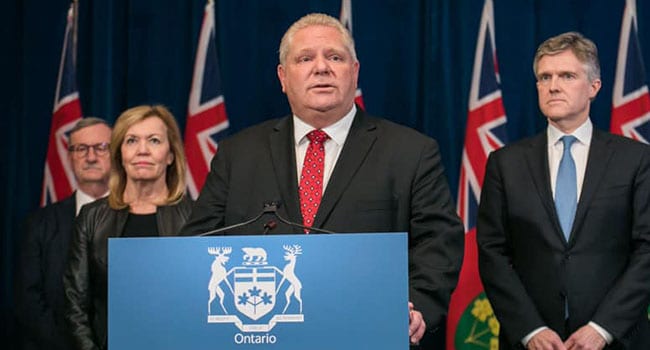 Ontario is the most indebted sub-sovereign borrower in the world.
Ontario is the most indebted sub-sovereign borrower in the world.
Interim financial results for the 2019-20 fiscal year show that the Ontario government ran a $9.2-billion deficit. According to estimates from economists, the deficit is likely to more than triple, largely as a result of the COVID-19 pandemic and economic lockdown, to around $29.3 billion in 2020-21.
While a large deficit is difficult to avoid during the current economic crisis, the resulting increase in debt makes it even more important for the provincial government to take decisive action to get the budget under control when the crisis has passed.
The Ontario debt burden has much to do with 15 years of ballooning spending under the former Liberal government from 2003 to 2018.
However, during their first two years in office, the Progressive Conservative government also hasn’t done much to restrain the cost of government. Nominal program spending in 2017-18 was $142.4 billion; in 2019-20, it was $153.1 billion.
Fortunately, if the government is searching for guidance on cutting spending, it doesn’t have to look far. While the platform on which the current government was elected in 2018 lacked good ideas on cutting spending, the PC platform one election earlier, in 2014, was full of them.
Remember former Ontario PC leader Tim Hudak’s plan to cut 100,000 public sector jobs?
It was a perfectly good idea in 2014 and it makes even more sense today.
Consider that in the early 2000s, excluding the self-employed, there were four private sector employees in Ontario for every one public sector employee at any level of government. Since then, there has been a marked shift towards public sector employment.
The ratio of private sector to public sector employees was 3.5 to one in 2019 and has since declined further as the private sector layoffs due to COVID-19 haven’t been matched by a reduction in public sector employment.
If Ontario had 135,000 fewer public sector workers and 135,000 more private sector workers last year, it would have had the same balance between private and public sector employment as the economy had in the early 2000s. In that light, reducing public sector employment by 100,000 seems entirely reasonable.
Ontario’s history is not without examples of the economic and fiscal benefits of public sector retrenchment.
In the mid-1990s, both the provincial government under Mike Harris and the federal government under Jean Chretien were working to get spending under control. As a result, public sector employment in Ontario fell by more than 90,000 jobs from 1994 to 1997.
This was more than offset by private sector growth, as total employment in Ontario rose by 277,000 over the same period.
The fiscal benefits of cutting public sector employment were significant. In 1994-95, the federal deficit was $36.6 billion and the Ontario deficit was $10.1 billion. By 1997-98, the federal government had a $3-billion surplus and Ontario had cut its deficit to $4 billion. Two years later, the Ontario government also balanced its budget.
History shows that a significant reduction in public sector employment is achievable and would do much to relieve the cost of government to taxpayers.
As soon as the Ontario government is done dealing with the COVID-19 crisis, its focus should turn to cutting public sector employment to restore the state of the province’s finances.
Matthew Lau is a research associate with the Frontier Centre for Public Policy.
The views, opinions and positions expressed by columnists and contributors are the author’s alone. They do not inherently or expressly reflect the views, opinions and/or positions of our publication.


